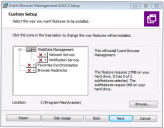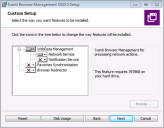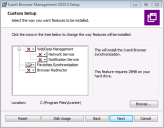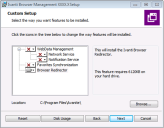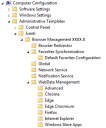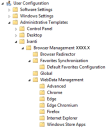Configure Browser Management
This topic describes how to select and configure the three key features available from Browser Management.
In this topic:
•Browser Management Policy Settings
WebData Management
To use the WebData Management feature of Browser Management, the WebData Management option must be selected for installation.
Install WebData Management only
The WebData Management component can be installed on its own and executed using a third-party mechanism. This approach avoids the installation of system level services which could be beneficial under some circumstances.
To install WebData Management only, from the Custom Setup dialog, ensure that only the high level WebData Management option is selected, then click Next.
Install WebData Management and Network Service option
The Network Service option installs the Ivanti Browser Management Network Service. This will automatically check for updates to the definition files on the Content Delivery Network (CDN) and download them as required.
To install WebData Management and its Network Service only, from the Custom Setup dialog, ensure that only these two options are selected, then click Next.
Install WebData Management and Notification Service option
The Notification Service option installs the Ivanti Browser Management Notification Service. This will automatically execute WebData Management during the logoff phase of each user session.
To install WebData Management and its Notification Service only, from the Custom Setup dialog, ensure that only these two options are selected, then click Next.
WebData Management - initial configuration
Once the WebData Management component has been installed it needs to be configured using the provided ADMX templates.
If you have installed the Notification Service and Network Service with WebData Management, the set of policies outlined below is recommended for getting started.
|
Policy |
Recommended Settings |
|---|---|
| Computer\Browser Management\Global |
License: Enabled Value: |
| Computer\Browser Management\Notification Service |
Enable WebData Management: Enabled Values: |
| Computer\Browser Management\Network Service | Enable Automatic Updates: Enabled |
| Computer\Browser Management\WebData Management | Default Configuration: Enabled |
For details of the Default Configuration refer to WebData Management.
Additional policies for Edge Chromium 88 and later
If you are using Microsoft Edge (Chromium) 88 or later, the Startup Boost feature may be enabled by default. If the feature is enabled an additional policy is required.
Without this policy setting, Microsoft Edge (Chromium) can run continuously and so prevent the execution of on Exit Clean up.
Further information is available in this article: https://techcommunity.microsoft.com/t5/articles/startup-boost-faq/m-p/1810423
|
Policy |
Recommended Settings |
|---|---|
| Computer\Microsoft Edge\Performance |
Enable startup boost: Disabled |
Favorites Synchronization
To use the Favorites Synchronization feature of Browser Management the Favorites Synchronization option must be selected for installation.
Install Favorites Synchronization
From the Custom Setup dialog, ensure the Favorites Synchronization feature is selected, then click Next.
The Notification Service is required for this feature and is installed automatically for the Favorites Synchronization component.
Favorites Synchronization - initial configuration
Once the Favorites Synchronization component has been installed it needs to be configured using the provided ADMX templates.
To get started with Favorites Synchronization the set of policies outlined below is recommended.
| Policy | Recommended Setting |
|---|---|
| Computer\Browser Management\Global |
License: Enabled Value: |
| Computer\Browser Management\Notification Service | Enable Favorites Synchronization: Enabled |
| Computer\Browser Management\Favorites Synchronization | Force Internet Explorer to close: Enabled |
| Computer\Browser Management\Favorites Synchronization |
Favorites Browser Selection: Enabled Values: Favorites Storage Folder: Enabled Value: Note, policies should be enabled only for browsers installed/in use. |
Additional policies for Edge Chromium 88 and later
If you are using Microsoft Edge (Chromium) 88 or later, the Startup Boost feature may be enabled by default. If the feature is enabled an additional policy is required.
Without this policy setting, Microsoft Edge (Chromium) can run continuously and may prevent synchronization from occurring.
Further information is available in this article: https://techcommunity.microsoft.com/t5/articles/startup-boost-faq/m-p/1810423
|
Policy |
Recommended Settings |
|---|---|
| Computer\Microsoft Edge\Performance |
Enable startup boost: Disabled |
Browser Redirector
To use the Browser Redirector feature of Browser Management the Browser Redirector option must be selected for installation.
Install Browser Redirector
From the Custom Setup dialog, ensure the Browser Redirector feature is selected, then click Next.
The Notification Service is required for this feature and is installed automatically for the Browser Redirector component.
Browser Redirector - initial configuration
Once the Browser Redirector component has been installed it needs to be configured using the provided ADMX templates.
To get started with Browser Redirector the set of policies outlined below is recommended.
Policy |
Recommended Setting |
|---|---|
| Computer\Browser Management\Global |
License: Enabled Values: |
| Computer\Browser Management\Notification Service |
Enable Browser Redirector: Enabled |
| Computer\Browser Management\Browser Redirector |
Specify Default Browser: Enabled URLs to redirect to Chrome: Enabled URLs to redirect to Firefox: Enabled URLs to redirect to Internet Explorer: Enabled URLs to redirect to Edge Chromium: Enabled
|
Microsoft Edge Chromium
For Microsoft Edge (Chromium) the following policy is required to allow the Edge Chromium Browser Redirector extension to be installed for all users.
Policy |
Recommended Setting |
|---|---|
| Computer\Microsoft Edge\Extensions |
Control which extensions are installed silently: Enabled Value: |
Google Chrome
If using Google Chrome the following policy is required to allow the Chrome Browser Redirector extension to be installed for all users.
Policy |
Recommended Setting |
|---|---|
| Computer\Google Chrome\Extensions |
Configure the list of force-installed apps and extensions: Enabled Value: |
Mozilla Firefox
If using Mozilla Firefox the following policy is required to allow the Firefox Browser Redirector extension to be installed for all users.
Policy |
Recommended Setting |
|---|---|
| Computer\Mozilla\Firefox\Extensions |
Extensions to Install: Enabled Value: |
User experience
It is recommended that the following policies are reviewed and implemented to ensure the best possible experience for users. These policies disable default browser checks and stop unwanted warnings and messages from being presented to users.
Policy |
Recommended Setting |
|---|---|
| Computer\Windows Components\Internet Explorer |
Automatically activate newly installed add-ons: Enabled Turn off add-on performance notifications: Enabled |
| Computer\Google Chrome |
Set Google Chrome as Default Browser: Disabled |
| Computer\Mozilla\Firefox |
Don’t Check Default Browser: Enabled |
| User\Windows Components\Internet Explorer |
Notify users if Internet Explorer is not the default web browser: Disabled |
Browser Management Policy Settings
Once the Group Policy template has been added, all options can be configured via the Group Policy Management Console.
Browser Management can be configured via Administrative Templates (.admx files) at the computer or user level.
Note, the Notification Service policies are only available at the computer level and are required to enable the various product features.
•Computer level ADMX :
Computer Configuration\Administrative Templates\Ivanti\Browser Management 2021.3\
•User Level ADMX:
User Configuration\Administrative Templates\Ivanti\Browser Management 2021.3\
Where policies are configured at both the computer and user level, the user level policies are applied.
Related topics
Policy Reference - WebData Management
